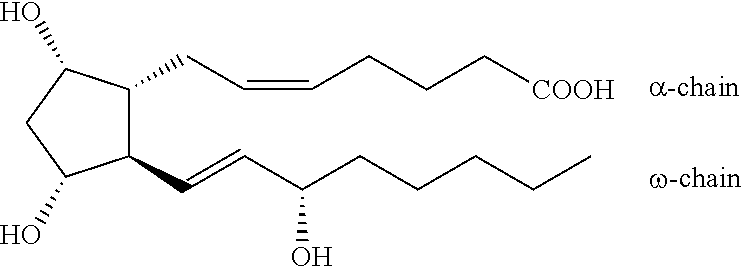Improved process for the production of bimatoprost
a technology of prostaglandins and prostaglandin analogs, applied in the direction of carboxylic acid amide preparation, organic chemistry, carboxylic acid amide separation/purification, etc., can solve the problems of insufficiently solving the problem, inability to compare the process with the prior art, and long reaction sequence, etc., to achieve the effect of long reaction time, laborious process and less efficien
- Summary
- Abstract
- Description
- Claims
- Application Information
AI Technical Summary
Benefits of technology
Problems solved by technology
Method used
Image
Examples
example 1
[0132]Synthesis of Compound (7) from Compound (6):
a)
[0133]A suspension of 33.1 g of (4-carboxybutyl)triphenylphosphonium bromide (MW=443.32; 7.5 equivalents) in 95 mL of THF was cooled to 0° C. At this temperature 139.4 g of a 2M solution of potassium-tert butoxide (MW=112.21; 9.5 equivalents) in THF were added drop wise over 30 min and stirring was continued at 0° C. for 30 min. The resulting orange red suspension was cooled to a mass temperature of −17° C. To the red ylide containing suspension a solution of 8 g of (3αR,4R,5R,6αS)-4-((R)-3-hydroxy-5-phenyl-pentyl)-hexahydro-cyclopenta[b]furan-2,5-diol (compound (6), MW=304.39; 1 equivalents) dissolved in 24 mL of THF was added over 30 min and the reaction mixture was stirred at −17° C. until complete conversion was detected. Then, 180 mL of brine were added to the slight orange cold suspension. The resulting decolorized suspension was stirred for 30 min at ≧−10° C. Then, the suspension was filtered over a G3 suction fun...
example 2
Bimatoprost (Via Mixed Anhydride with Pivalic Acid)
[0137]Synthesis of Compound (7) from Compound (6):
a)
[0138]A suspension of 33.1 g of (4-carboxybutyl)triphenylphosphonium bromide (MW=443.32; 7.5 equivalents) in 95 mL of THF was cooled to 0° C. At this temperature 139.4 g of a 2M solution of potassium-tert butoxide (MW=112.21; 9.5 equivalents) in THF were added drop wise over 30 min and stirring was continued at 0° C. for 30 min. The resulting orange red suspension was cooled to a mass temperature of −17° C. To the red ylide containing suspension a solution of 8 g of (3αR,4R,5R,6αS)-4-((R)-3-hydroxy-5-phenyl-pentyl)-hexahydro-cyclopenta[b]furan-2,5-diol (compound (6), MW=304.39; 1 equivalents) dissolved in 24 mL of THF was added over 30 min and the reaction mixture was stirred at −17° C. until complete conversion was detected. Then, 180 mL of brine were added to the slight orange cold suspension. The resulting decolorized suspension was stirred for 30 min at ≦−10° C. Then, the suspe...
example 3
Bimatoprost (Via Mixed Anhydride with Ethyl Chloroformate)
[0140]a) 12.3 g of compound (7) were prepared as described in example 2a.
b)
[0141]250 mL of methylene chloride were added to 12.3 g of (Z)-7-[(1R,2R,3R,5S)-3,5-dihydroxy-2-((R)-3-hydroxy-5-phenyl-pent-1-enyl)-cyclopentyl]-hept-5-enoic acid (compound (7), MW=402.54; 26.1 mmol; 1 equivalents). The solution is cooled to −10° C. At this temperature 5.1 g of triethylamine (MW=101.19; 50.4 mmol; 1.9 equivalents) and 5.1 g of ethyl chloroformate (MW=108.52; 48.1 mmol; 1.8 equivalents) were added and the mixture was stirred for two hours. A solution of 2.3 g of ethylamine (MW=45.08; 2.0 equivalents) in 10 mL methylenehloride was added. After stirring the reaction mixture for two hours at −10° C., the mixture was warmed to room temperature. The reaction was quenched by addition of 250 mL of water and the pH is adjusted to 2.0 with 1M aqueous hydrochloric acid. After separation of the layers, the organic layer was washed with 250 mL of ...
PUM
| Property | Measurement | Unit |
|---|---|---|
| temperature | aaaaa | aaaaa |
| temperature | aaaaa | aaaaa |
| volume | aaaaa | aaaaa |
Abstract
Description
Claims
Application Information
 Login to View More
Login to View More - R&D
- Intellectual Property
- Life Sciences
- Materials
- Tech Scout
- Unparalleled Data Quality
- Higher Quality Content
- 60% Fewer Hallucinations
Browse by: Latest US Patents, China's latest patents, Technical Efficacy Thesaurus, Application Domain, Technology Topic, Popular Technical Reports.
© 2025 PatSnap. All rights reserved.Legal|Privacy policy|Modern Slavery Act Transparency Statement|Sitemap|About US| Contact US: help@patsnap.com



